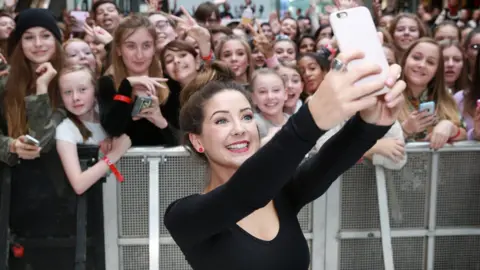Instagram: How much do social influencers earn?
 PA
PAFormer Love Island contestant Olivia Buckland has become the latest reality TV star to fall foul of the UK's advertising watchdog, after she failed to specify one of her Instagram posts had been sponsored by a brand.
But disciplinary action is unlikely to dampen enthusiasm in an area that has grown from an advertising niche to a worldwide phenomenon in less than a decade.
So, how much money are people making from social media?
Kat Richardson, creative director of influencer marketing agency WaR, tells the BBC that users need around 10,000 followers before they can "start making anything".
'Well into six figures'
Payment for those users is "fairly low level" - around £100 for an Instagram post - she says. But it can progress quite quickly after that.
"Once you get to 30,000 followers, for a fashion or beauty post, you could be looking at around £750," she says.
Rohan Midha, the managing director of influencer agency PMYB, adds that small - or "micro" - influencers can get paid with free products while larger accounts will get "well into the six figures".
Long-standing relationships between brands and influencers tend to be more beneficial - for both parties - compared with single posts.
"What we have found through our data is that one-off posts don't lead to a really credible endorsement," he says. "The best results occur when the influencer promotes over a longer period of time."
Even so, Kat says Instagram accounts with around a million followers can command £10,000 for a one-off post.
 PA
PABut the size of a following does not necessarily equate to the size of a pay cheque.
There are "many variables" in partnerships between brands and influencers, she says.
Kat explains: "On Instagram, for example, it's more expensive if you have a swipe up for the brand's site. It's more expensive if there are links to certain products, it's also more expensive if you're doing Instagram stories or if you're writing about it in your blog and your linking to it in your Instagram.
"It all comes as a package that can be sold to the brand and boost your monetary value."
At the top end of the scale, people like reality TV star Kylie Jenner - who has more than 116 million followers on Instagram, 25 million on Twitter and 21 million on Facebook - can earn around £750,000 for one post.
Advice for hopefuls
So what do budding influencers hoping to make a living from their online presence need to do?
"The fundamental concept is that people buy from people they trust and admire," says Rohan. "If an influencer has the ability to make their audience act, then brands are likely to pay them to promote a product or service."
Kat adds it is important "not to post too much sponsored content", adding: "Your audience will get very vocal if you're doing too much."
"Also, it's important to post brands that work for you," she says. "If you're normally associated with beauty and then you're pictured with a household product that might sit better with a mummy blogger then people are going to push back against that, they're not going to engage with it."
The choice of platform can also affect potential partnerships.
Allow Instagram content?

Kat explains that brands are far less interested in promoting through Facebook and Twitter than they were at the beginning of the decade.
"Instagram stories is now huge," she says. "That definitely has more power now."
"You get a lot of people who are looking at their phones on their commute on their way into work, so Instagram is an easy way of looking through people's feeds.
"You like something, you click on it and buy it - it's a very easy way to do it in the morning."
Youtube, she adds, is seen as "more focused towards a younger audience".
So what is it exactly that has made influencing so popular, and why are brands turning to it over traditional advertising?
"I think it's because you get a little bit more depth to the story," says Kat. "When you're looking at an advert for something, there's no personal story behind that but when you follow an influencer then there's already something you've decided about that person that you like.
"You've got an awareness of who they are and you've already bought into their lifestyle and when they post a product there's already a link there for you."
